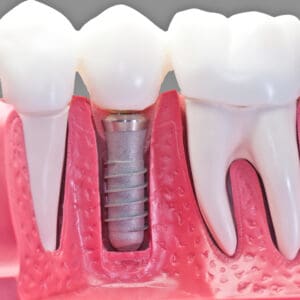
Advantages Over Dentures or Bridges
Implants are fixed (non-removable) and provide a long lasting, convenient treatment option. They are easier to eat with and clean than a traditional restoration appliance, like a bridge or partial denture. Aesthetically, they look and feel like regular teeth. Compared to a bridge, an implant requires no modification of the adjacent teeth, providing a conservative treatment option and maintaining as much healthy tooth structure as possible.
Dr. Dickinson performs full and partial 3D computer-guided implant placement right here in our Arlington, WA dental office. This allows for a more efficient and conservative surgical procedure. With the aid of the guide, Dr. Dickinson can place the implant exactly as planned, as opposed to a free-hand implant placement.
Implants are easy to maintain with regular brushing and flossing. Regular visits for professional teeth cleaning at our Arlington, WA dental office are necessary to keep your implant—and the rest of your natural teeth—as healthy as possible.
Implant Services

- Autogenous Bone Grafting: Occasionally, the ideal areas for dental implants do not have sufficient bone quantity to support the implants. In these cases, it is often necessary to “borrow” bone from another area of your mouth and graft it into the deficient area. Often, the area of choice is from the chin or in the back of the jaw where your wisdom teeth used to be.
- Implant Site Development: When a tooth needs to be removed due to infection, it is not uncommon to have lost bone around the infected tooth. In these cases, various types of bone grafting can be done at the same time the tooth is removed to facilitate the placement of a dental implant at a later date.
- Computer-Enhanced Treatment Planning: We have special software on our computer that allows us to evaluate your dental CT scan in three dimensions for bone quality, bone quantity, and bone location, enabling the best possible placement of your dental implants. This also allows us to work closely and smoothly with your restorative dentist to ensure an ideal result where your dental implants are concerned.
- Implant Maintenance: Once your dental implant restoration is completed, it is important to keep the area clean and infection-free. Dental implants can accumulate plaque and tartar just as teeth can. Whether you have just one tooth replaced by an implant or several, a professional cleaning schedule will be necessary to keep your implants healthy. The time interval for these professional cleanings will be determined by your individual needs.
